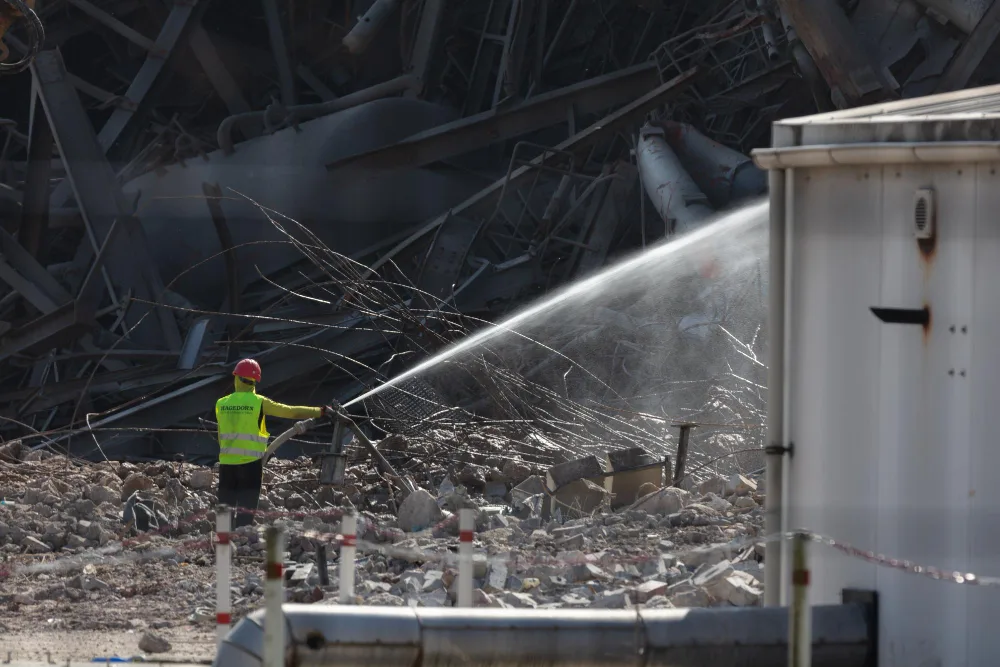Dust control is a critical aspect of demolition projects, ensuring the safety of workers, minimising environmental impact, and complying with regulations. During demolition activities, significant amounts of dust and particulate matter can be generated, posing risks to respiratory health, visibility, and air quality. Implementing effective dust control solutions are essential to mitigate these risks and create a dust-free safe working environment.
Neglecting dust management can lead to severe consequences, including respiratory issues for workers, complaints from neighbouring communities, and potential fines or legal actions for non-compliance with environmental regulations. Now in this blog, we will explore the top five highly effective dust control solutions for safe demolition practices.
1. Water Spray Systems
Water spray systems typically consist of a water source, a pump, a network of pipes or hoses, and strategically placed nozzles or sprinklers. The water is pressurised and distributed through the system, creating a fine mist or stream that captures and weighs down dust particles.
Benefits:
- Effective dust suppression: Water spray systems are highly effective in capturing and suppressing dust particles, significantly reducing airborne particulate matter.
- Cost-effective: Compared to other dust-managing solutions, water spray systems are generally more cost-effective, especially when water is readily available on-site.
- Versatile application: Water spray systems can be adapted to various demolition work scenarios, including interior and exterior environments.
Considerations:
- Water availability: Ensure a reliable water source is available on-site or nearby to maintain a consistent water supply.
- Freezing temperatures: In colder climates, precautions must be taken to prevent water lines from freezing, which could disrupt the system’s operation.
- Overspray: Careful planning and nozzle placement are necessary to minimise overspray and potential water damage to surrounding areas.
Also read: key technologies in demolition and excavation process
2. Misting Cannons
Misting cannons, also known as dust suppression cannons or fog cannons, are powerful dust-managing solutions that utilise specialised nozzles to create a fine mist or fog. Misting cannons consist of a water source, a high-pressure pump, and a specialised nozzle or ring of nozzles. The water is pressurised and forced through the nozzles, creating a fine mist or fog that effectively captures and suppresses dust particles. These systems can be mounted on trailers or fixed locations and can be adjusted to target specific areas or cover a wide radius.
Benefits:
- Extensive coverage: Misting cannons can cover a large area, making them suitable for large-scale demolition projects or open-air environments.
- Efficient dust suppression: The fine mist or fog created by misting cannons effectively captures and weighs down dust particles, preventing them from becoming airborne.
- Adjustable throw distance and direction: Many misting cannons feature adjustable throw distances and directional controls, allowing for targeted dust suppression in specific areas.
Considerations:
- Initial investment: Misting cannons tend to have a higher initial investment cost compared to simpler water spray systems.
- Water consumption: Due to their extensive coverage, misting cannons may consume more water, necessitating a reliable water source or water management plan.
- Wind conditions: Strong winds can potentially disrupt the mist or fog pattern, reducing the effectiveness of the system.
3. Dust Suppression Agents: Chemical Solutions
Dust control agents, also known as dust suppressants or dust palliatives, are chemical solutions designed to bind and stabilise dust particles, preventing them from becoming airborne. These agents come in various forms, including liquids, powders, or granules. They are typically applied through spraying, mixing, or spreading techniques. Once applied, these agents chemically react with the dust particles, forming a crust or binding them together, effectively minimising the generation of airborne dust.
Benefits:
- Long-lasting effectiveness: Depending on the specific agent and application method, dust suppression agents can provide long-lasting dust suppression, reducing the need for frequent reapplication.
- Versatile application: Dust suppression agents can be used in various demolition work scenarios, including interior and exterior environments, stockpiles, and unpaved surfaces.
- Environmentally friendly options: Many modern dust suppression agents are formulated with eco-friendly or biodegradable components, minimising environmental impact.
Also read: how to properly dispose construction and building waste
Considerations:
- Compatibility with site conditions: Different dust suppression agents may perform better under specific site conditions, such as soil type, moisture levels, and climate. Proper selection and application are crucial.
- Potential for residue or discolouration: Some dust suppression agents may leave residues or discolour surfaces, which may require additional cleaning or preparation for subsequent activities.
- Safety precautions: Follow manufacturer guidelines and safety protocols when handling and applying dust suppression agents, as some may contain hazardous components.
4. Enclosures and Barriers
Enclosures and barriers are physical methods used to contain and isolate dust generated during demolition activities. These solutions create a barrier between the demolition work site and the surrounding environment, preventing the spread of dust and minimising its impact on adjacent areas. Enclosures typically involve constructing temporary structures, such as tents or scaffolding covered with protective sheeting, around the demolition site. Barriers, on the other hand, can include fences, walls, or curtains made of materials like plastic or fabric, strategically placed to contain dust within the demolition work area.
Benefits:
- Effective dust containment: Properly designed and constructed enclosures and barriers can effectively contain dust within the designated work area, minimising its spread to surrounding areas.
- Protect adjacent areas: By containing dust, enclosures and barriers help protect nearby buildings, infrastructure, and communities from the potential impact of airborne particulates.
- Compliance with regulations: In many regions, enclosures or barriers may be required by environmental regulations to control dust emissions from demolition projects.
Considerations:
- Initial setup costs: Constructing enclosures or installing barriers can involve significant initial costs, including materials, labour, and potential engineering considerations.
- Site accessibility: Enclosures and barriers may impact site accessibility and require careful planning for material and equipment movement.
- Maintenance and monitoring: Regular maintenance and monitoring of enclosures and barriers are necessary to ensure their effectiveness and address any potential breaches or damage.
Also read: 5 red list building materials to avoid
5. Vacuum/Hydraulic Excavation
Vacuum and hydraulic excavation techniques are innovative approaches to dust-managing that minimise the generation of airborne particles during demolition activities. Vacuum excavation utilises powerful suction systems to remove soil, debris, or other materials from the work area. The materials are collected and contained within a sealed tank or container, preventing the release of dust into the surrounding environment. Hydraulic excavation, on the other hand, uses high-pressure water jets to loosen and remove materials, which are then collected and contained using vacuum systems or other debris management methods.
Benefits:
- Minimal dust generation: By minimising the disturbance of materials, vacuum and hydraulic excavation techniques significantly reduce the generation of airborne dust during demolition activities.
- Precise material removal: These techniques allow for precise and controlled removal of materials, minimising collateral damage and reducing the potential for dust creation through excessive demolition.
- Environmental compliance: Vacuum and hydraulic excavation methods can help meet stringent environmental regulations by effectively containing and managing dust and debris.
Considerations:
- Equipment costs: Specialised vacuum and hydraulic excavation equipment can be costly, potentially increasing project expenses.
- Skilled operators: These techniques require trained and experienced operators to ensure safe and effective execution.
- Site accessibility: Adequate space and access may be required to accommodate the necessary equipment and debris management systems.
Finding Reliable Dust Control Demolition Near Me
When starting a demolition project, partnering with experienced professionals who prioritise dust management is essential. Searching for “dust control demolition near me” can help you find reputable local contractors specialising in safe and environmentally responsible demolition work services. These experts can assess site conditions, recommend suitable dust prevention methods, and ensure compliance with local regulations. Collaborating with trusted dust prevention demolition experts minimises risks, reduces environmental impact, and ensures a safe, efficient process.
In conclusion, Implementing effective dust control solutions is a critical aspect of safe and responsible demolition practices. By prioritising dust management, you not only safeguard the health and well-being of workers but also minimise environmental impact and maintain compliance with applicable regulations.
The top five dust control solutions discussed in this article – water spray systems, misting cannons, dust suppressing agents, enclosures and barriers, and vacuum/hydraulic excavation that offer diverse approaches to address the unique challenges of each demolition project. By carefully evaluating the site conditions, project requirements, and regulatory considerations, you can select the most appropriate combination of dust management methods to achieve optimal results.



